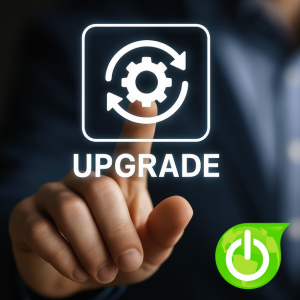 In today’s digital world, our devices are more than just tools – they’re essential to how we work, communicate, learn, and relax. But like any piece of technology, phones, laptops, tablets, and desktops don’t last forever. Whether it’s slowing performance, compatibility issues, or hardware issues, every device eventually reaches the end of its useful life.
In today’s digital world, our devices are more than just tools – they’re essential to how we work, communicate, learn, and relax. But like any piece of technology, phones, laptops, tablets, and desktops don’t last forever. Whether it’s slowing performance, compatibility issues, or hardware issues, every device eventually reaches the end of its useful life.
Here are some telltale signs that your device may be ready for retirement and the benefits of making a timely upgrade.
Sluggish Performance
One of the first signs your device may need to be replaced is a noticeable drop in speed. If simple tasks like opening apps, loading web pages, or starting up the system take far longer than they used to, it might be more than just a software hiccup.
Even after updates, system cleanups, or resets, an aging processor or low RAM can make your device lag significantly. As applications and operating systems become more demanding, older hardware struggles to keep up.
Frequent Crashes and Freezes
Is your device crashing or freezing frequently? Random shutdowns, the dreaded “blue screen of death” (on Windows), or spinning beachballs (on macOS) can signal deeper hardware issues. These problems are often tied to failing components such as the hard drive, graphics card, or memory.
While some issues can be repaired, repeated crashes usually point to a device nearing the end of its lifespan.
Outdated Operating System
If your device is too old to support the latest operating system updates, it’s a red flag. Manufacturers regularly release updates not only for features but also for security patches. An unsupported device puts your data at risk and limits your access to new software or services.
When your OS is no longer being updated or you are unable to upgrade to the newest version, replacing the device is important to follow through with.
Battery Life is Fading Fast
Mobile devices like smartphones and laptops rely heavily on battery performance. If your battery drains quickly, overheats, or refuses to charge properly, it can severely limit the device’s usefulness.
While batteries can sometimes be replaced, in many cases, especially with older or sealed devices, it’s more cost-effective to replace the entire unit.
Storage is Always Full
If you’re constantly battling with storage issues, despite regularly deleting files or using cloud storage, your device may simply no longer be a good match for you.
Photos, videos, applications, and system files require more space than ever. When your storage limits are holding you back from doing even basic tasks, it might be time for a device with more capacity.
Incompatible Apps or Peripherals
It is critical to make sure your devices have the latest software updated. Newer applications often require updated hardware and software to function properly. If you’re unable to install or run certain apps or connect newer accessories (e.g., printers, headsets, USB-C devices), your hardware may be outdated.
This incompatibility can affect everything from work productivity to entertainment and communication.
Repairs Are Becoming Frequent—or Expensive
Are you finding yourself constantly fixing your device or spending more on maintenance than the device is worth? Repair costs can add up quickly, especially if key components like the motherboard, screen, or internal storage fail.
When repair bills start to approach the price of a new device, it’s usually a smarter investment to upgrade.
So, what can you gain from replacing your outdated tech?
Improved Speed and Performance
Modern devices are built for today’s multitasking demands. With faster processors, more RAM, and optimized storage, you’ll experience smoother and more responsive performance for everything from browsing to gaming.
Enhanced Security
New devices come with the latest security features, encryption standards, and regular software updates to protect your personal and professional data.
Better Battery Efficiency
Battery life has significantly improved in recent years. New devices not only last longer but also charge faster and more safely.
Access to New Features, Security and Technology
From AI-powered apps to high-resolution displays, facial recognition, and 5G connectivity, new devices give you access to features that older models simply can’t support.
Reduced Energy Consumption
Newer devices are generally more energy-efficient, which is not only better for your electricity bill but also for the environment.
Peace of Mind
Knowing that your device is reliable, secure, and supported allows you to focus on what matters without the stress of crashes, compatibility issues, or lost productivity.
Technology is evolving faster than ever, and while it’s tempting to hang onto your current device as long as possible, the downsides of using outdated tech often outweigh the costs of an upgrade. If your device shows multiple signs of age and performance decline, it might be time to explore newer options that can keep up with your needs and lifestyle.
Upgrading isn’t just about having the latest gadget, it’s about ensuring your tools work for you, not against you.
